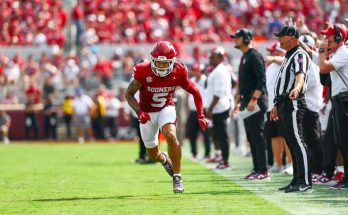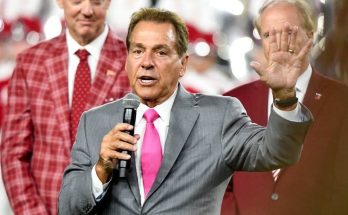College football has seen its share of unforgettable moments, legendary performances, and cultural ripple effects that have stretched far beyond the field. But what Adrian Peterson and Trent Williams just accomplished has nothing to do with touchdowns or pancake blocks—and yet, it might be the most impactful move either man has ever made in their respective careers. In a groundbreaking, unprecedented gesture, the two NFL icons have donated a combined $78 million to their former universities and surrounding communities, stunning the college football world and redefining what it means to leave a legacy in motion.
The announcement came with no pomp or parade. No spotlight-chasing or press-hungry performance. It dropped like a thunderclap on social media, with a joint statement emphasizing their mission: “We’re paying it forward, not for recognition, but because someone once believed in us. Now it’s our turn.” That one sentence reverberated through the halls of every athletic department in the nation.
Adrian Peterson, a Heisman finalist and all-time Oklahoma great, and Trent Williams, a former All-American offensive tackle at the same university, have always been larger than life in their own right. Peterson—the bruising, electrifying back who carved up college defenses before rewriting NFL rushing records. Williams—the quietly dominant protector whose footwork and strength made him one of the most respected linemen in football history. Both men rose from humble beginnings to generational wealth and fame, but neither forgot the institutions and communities that first gave them a shot. With this transformative donation, they’re proving that greatness doesn’t end when you hang up your cleats. In fact, for them, it was just the beginning.
Of the $78 million, Peterson has allocated $40 million toward the University of Oklahoma’s athletic and academic infrastructure, while pledging an additional $10 million to local youth programs and scholarship funds for underrepresented students. Williams, not to be outdone, has earmarked $20 million for facilities development, NIL support systems, and athlete wellness initiatives, while directing $8 million toward economic revitalization in underserved neighborhoods near the OU campus. It’s not just about building new weight rooms or indoor practice fields. It’s about making sure the next generation—athlete or not—has a fighting chance to build something lasting, with opportunity at their fingertips and support behind every door.
To say this act is historic would be putting it lightly. No other active or retired NFL players have ever made a private donation of this magnitude to a college sports program. It dwarfs previous gifts from alumni and boosters. It exceeds some university-wide fundraising drives. But more than the number, it’s the intent that’s shaking the system. Peterson and Williams are not just giving back—they are restructuring what it means to invest in the future.
When asked why now, Peterson said in an interview, “Because waiting doesn’t help the kid who needs that mentor today. Because I’ve seen how a timely opportunity can change a life. I wouldn’t be here without one.” For Williams, the decision was equally personal. “I came from District 3 in Longview, Texas. I know what it’s like to want more but not see the road. We’re building roads. We’re building bridges. And this time, we’re not asking anyone else to pay for them.”
The news has already ignited a firestorm of admiration and reflection across college football and beyond. Oklahoma head coach Brent Venables called it “a Godsend—bold, generous, and rooted in love.” University president Joseph Harroz Jr. described it as “a landmark moment not just for Oklahoma, but for collegiate sports nationwide.” Social media erupted with tributes, testimonials, and open gratitude from current student-athletes who now know that their dreams are being protected and powered by legends they once idolized.
But beyond the excitement lies a deeper current. Peterson and Williams are not just helping OU football—they’re challenging the culture of collegiate athletics. Their donation directly addresses some of the most pressing issues in the modern game: the need for better mental health support, the long-overdue investment in educational access for athletes, and the growing pressure surrounding Name, Image, and Likeness (NIL) compensation structures. While many criticize NIL deals and shifting priorities in college sports, Peterson and Williams chose to engage with these issues head-on, not by resisting change, but by steering it toward equity and sustainability.
They’ve already formed a board of advisors—including former athletes, educators, and financial experts—to ensure the money is stewarded responsibly and its effects are felt immediately. Their initiative includes mandatory life skills programming, financial literacy training, and post-graduation job placement services for all athletes under the umbrella of the donation’s impact. It is, in essence, a comprehensive ecosystem—one built by former players who understand the gaps in the system because they’ve lived through them.
It also sends a message to other successful alumni across the country. What if every former player who signed a $100 million contract gave back even 1% to their alma mater or community? What would that mean for facilities, education, housing, or access to healthcare? Peterson and Williams are setting a new standard—and whether intentionally or not, they’re daring others to rise to it.
Already, whispers are circulating that other major names in the NFL are considering similar moves. The ripple effect is real. Coaches across the country are scrambling to understand how to position their programs not just as winning teams, but as holistic launchpads for life after football. Recruiting conversations are shifting too—after all, which high school prospect wouldn’t be drawn to a university where legends are actively investing in their future?
And yet, perhaps the most beautiful part of this story isn’t the headlines or dollar signs. It’s the quiet humanity behind it. The memory of a coach who bought Peterson’s first cleats when he couldn’t afford them. The image of Williams sleeping on a teammate’s couch as a freshman before getting a scholarship. The fire that never left either of them, to make sure no one else ever had to go through that alone.
Legacy in motion. It’s not just a phrase—it’s a declaration. Peterson and Williams could have spent this money on yachts, real estate, or business ventures. They chose, instead, to invest in people. In future doctors, architects, engineers, artists, and yes, athletes. In the kids from Norman to Longview who will grow up knowing they’re not forgotten, not overlooked, and not alone.
As of this writing, construction has already begun on a new multi-purpose athletic-academic complex bearing both of their names. Local high schools in Oklahoma and Texas are also set to receive resources for mental health counseling, tutoring, and upgraded athletic gear by next season. Community leaders say the money has already started circulating, creating jobs, and giving parents a renewed sense of hope. The power of two men who simply decided to give back is echoing far louder than any game-winning play ever could.
This is a seismic moment in sports philanthropy. Not for the spectacle, but for the substance. Peterson and Williams have proven that real power doesn’t lie in what you have—it lies in what you give. Their gift will echo through locker rooms and classrooms, neighborhoods and families, for generations. This is not a retirement move. This is a revolution.
They didn’t just donate $78 million. They rewrote the playbook. And in doing so, they left a legacy not measured in records or trophies—but in lives changed.



